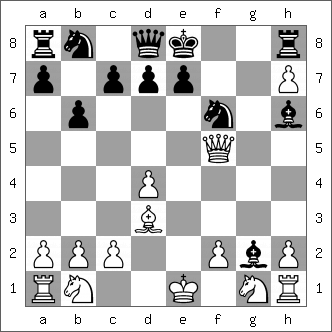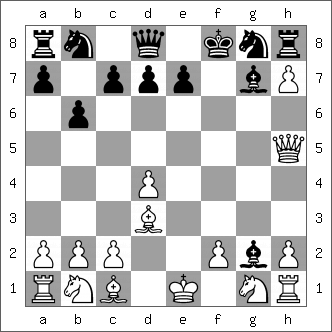Every now and then I search through openings long discarded by chess theory, no matter how distrusted they may be, both for entertainment's sake and for the hope of finding something of value, at least to serve as a surprise weapon.
I'll give here an example of an investigation that ultimately proved fruitless, except that I concluded that at least some books have inaccurate analysis of an abandoned Owen's Defence line, which I tried to re-habilitate in vain. It's a good line for players of any strength to examine since it's tactical, i.e. there is little need for sophisticated and disputable positional evaluations. It seems like good material for chesstalk as well, since there are only a small number of critical lines. If anyone has specialist book(s) on the Owen's, feel free to comment.
After the initial moves 1.e4 b6 2.d4 Bb7 3.Bd3
one day I decided to re-check some old analysis on the sharp move
3...f5?!
which is thought to be absolutely losing for Black, by more than one refutation, after the critical
4.exf5! Bxg2 5.Qh5+ g6 6.fxg6 Bg7
when White is thought to have two winning continuations:
A) 7.Qf5 Nf6 8.Bh6 Bxh6 9.gxh7

Here both ECO and MCO-15 quote Bruder-Vegener, corr 1982, which went 9...Bxh1 10.Qg6+ Kf8 11.Qxh6+ Kf7 12.Nh3 when White was winning.
ECO quotes Bruder as giving the alternative 9...Bc1 10.Qg6+ Kf8 11.Qxg2 Bxb2 12.Ne2! with a winning attack on the g-file.
It seems to me that 9...Be4 and 9...d5 are only slight improvements, but simply 9...e6 doesn't appear to clearly lose for Black. There may be just a large edge for White, but Black may even have some compensation (after White picks up the g2-bishop starting with 10.Qg6+).
That leaves the other (true) refutation of 3...f5 that starts with
B) 7.gxh7+ Kf8

Here ECO gives 8.Ne2 Bxh1 9.Nf4 Nf6 10.Ng6+ Ke8 11.Nxh8+ Nxh5 12.Bg6+ Kf8 13.Bxh5 e5 14.Ng6+ Kf7 15.Nxe5+ Ke6 16.Bg4+ Kd5 17.Bf4 Ke4 18.Be3 1-0 Lalev-Trifonov, Bulgaria 1985.
This game may not have been checked with a computer by the editors at all, as Fritz proposes more than one big improvement for Black along the way, starting with 8...Nf6.
ECO gives a less serious alternative in 8.hxg8Q+ Kxg8 9.Qg4 Bxh1 10.h4 Bd5! 11.h5 Be6 12.Qg2 Rxh5 13.Qxa8 Bd5 14.Qxa7 Nc6 15.Qa4 Rh1, with compensation, Shmit-Vitolinsh, USSR 1969.
Finally, there is the strongest move, possibly the only clear refutation of 3...f5, which ECO doesn't mention: 8.Nf3!

Now Black's following moves are absolutely forced, as a computer will show:
8...Nf6 9.Qg6 Bxf3 10.Rg1 Rxh7 11.Qg3 Be4 12.Bxe4 Nxe4 13.Qf3+
Black is now lost whether he plays 13...Nf6 allowing 14.Qxa8, or in case of 13...Kg8 14.Qxe4 when the exposure of Black's king ensures that he should lose.
If there is significant interest in the general topic of this thread, I may later post some ideas I have on the Latvian Gambit, where there may be more hope for Black, though again I don't have specialty books on that opening.
I'll give here an example of an investigation that ultimately proved fruitless, except that I concluded that at least some books have inaccurate analysis of an abandoned Owen's Defence line, which I tried to re-habilitate in vain. It's a good line for players of any strength to examine since it's tactical, i.e. there is little need for sophisticated and disputable positional evaluations. It seems like good material for chesstalk as well, since there are only a small number of critical lines. If anyone has specialist book(s) on the Owen's, feel free to comment.
After the initial moves 1.e4 b6 2.d4 Bb7 3.Bd3
one day I decided to re-check some old analysis on the sharp move
3...f5?!
which is thought to be absolutely losing for Black, by more than one refutation, after the critical
4.exf5! Bxg2 5.Qh5+ g6 6.fxg6 Bg7
when White is thought to have two winning continuations:
A) 7.Qf5 Nf6 8.Bh6 Bxh6 9.gxh7
Here both ECO and MCO-15 quote Bruder-Vegener, corr 1982, which went 9...Bxh1 10.Qg6+ Kf8 11.Qxh6+ Kf7 12.Nh3 when White was winning.
ECO quotes Bruder as giving the alternative 9...Bc1 10.Qg6+ Kf8 11.Qxg2 Bxb2 12.Ne2! with a winning attack on the g-file.
It seems to me that 9...Be4 and 9...d5 are only slight improvements, but simply 9...e6 doesn't appear to clearly lose for Black. There may be just a large edge for White, but Black may even have some compensation (after White picks up the g2-bishop starting with 10.Qg6+).
That leaves the other (true) refutation of 3...f5 that starts with
B) 7.gxh7+ Kf8
Here ECO gives 8.Ne2 Bxh1 9.Nf4 Nf6 10.Ng6+ Ke8 11.Nxh8+ Nxh5 12.Bg6+ Kf8 13.Bxh5 e5 14.Ng6+ Kf7 15.Nxe5+ Ke6 16.Bg4+ Kd5 17.Bf4 Ke4 18.Be3 1-0 Lalev-Trifonov, Bulgaria 1985.
This game may not have been checked with a computer by the editors at all, as Fritz proposes more than one big improvement for Black along the way, starting with 8...Nf6.
ECO gives a less serious alternative in 8.hxg8Q+ Kxg8 9.Qg4 Bxh1 10.h4 Bd5! 11.h5 Be6 12.Qg2 Rxh5 13.Qxa8 Bd5 14.Qxa7 Nc6 15.Qa4 Rh1, with compensation, Shmit-Vitolinsh, USSR 1969.
Finally, there is the strongest move, possibly the only clear refutation of 3...f5, which ECO doesn't mention: 8.Nf3!
Now Black's following moves are absolutely forced, as a computer will show:
8...Nf6 9.Qg6 Bxf3 10.Rg1 Rxh7 11.Qg3 Be4 12.Bxe4 Nxe4 13.Qf3+
Black is now lost whether he plays 13...Nf6 allowing 14.Qxa8, or in case of 13...Kg8 14.Qxe4 when the exposure of Black's king ensures that he should lose.
If there is significant interest in the general topic of this thread, I may later post some ideas I have on the Latvian Gambit, where there may be more hope for Black, though again I don't have specialty books on that opening.


Comment